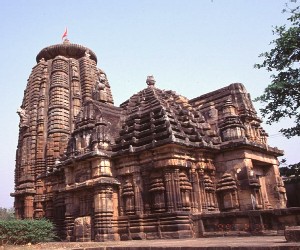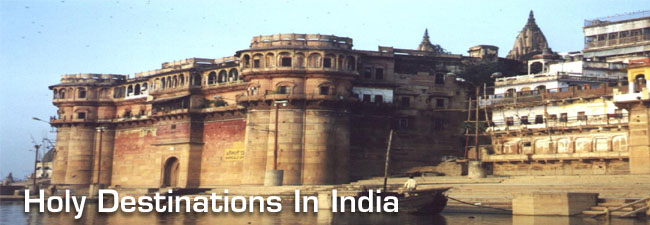 Bhubaneswar
Bhubaneswar
Pilgriamage Attractions of Bhuvaneshwar
Festivals The ancient capital of the Kalinga Empire, and now
the capital of Orissa, Bhubaneswar's history goes back over
2000 years. "Bhubaneshwar" means the "abode of
God" or "master of the universe" and it was also,
once known as the 'Cathedral of the East', on account of the
large number of shrines. At one time, over 7000 temples bordered
the Bindu Sagar tank. Of these, 500 still survive, all built
in the extravagant Oriya style. It is of these temples, that
the great poet, Rabindranath Tagore had once said - 'At all
places where the eye rests, and also at places where the eye
does not rest, the busy chisel of the artist has worked incessantly.
The abode of god has been enveloped by a variety of figures
depicting the good and the evil, the great as well as the insignificant,
the daily occurrences of human life....'
State : Orissa
Significance : Capital of Orissa
Related Links : Lingaraja Temple, Muktesvara Temple
How to Get there
There On the National Highway linking Kolkata (480 km) and
Chennai (1225 km). Air links to Delhi, Kolkata, Hyderabad and
Nagpur. Rail links to Kolkata, Chennai, Delhi (1745 km), Mumbai
(1691 km).
To Top Pilgriamage Attractions of Bhuvaneshwar
Temples
Most of the temples are located near the Bindu-sarovara Tank,
which is about two km south of the city centre. Lingaraja and
Vital Duel Temples are located west of the tank. Parasumaresvara
and Muktesvara temples are east of the tank. The Rajrani and
Brahmesvara Temples are a ten to fifteen-minutes walk east of
the Muktesvara Temple.
Lingaraja Temple (11th century)
The presiding deity is the svayambhu linga, Hari-Hara Linga,
which is half Shiva and half Vishnu. He is also named Tribhuvaneswara,
the Lord of the three worlds. The linga of Lingaraja, or Krittivasas,
is an uncarved block of granite 8 feet in diameter raised 8
inches above the ground. The Shiva linga is bathed daily with
water, milk and bhang. There are many other deities in the temple.
In the northeast corner of the temple there is a deity of Parvati.
Muktesvara Temple
Built in the 10th century; this small elegant temple has been
described as the most exquisitely ornamented temple in Bhubaneswar.
It has an 11m (35 feet) high tower. The sandstone carvings are
the most notable feature of this temple. It is also known for
its ornamental gateway, carved dwarves, and intricate motif
carvings of a smiling lion, adorned with beaded tassels in its
mouth. Muktesvara means the Lord who bestows freedom through
yoga. The Siddeswara Temple is on the same grounds and has a
Ganesh deity.
The small Marichi Kund, between the Mukesvara Temple and the
road, is known to cure infertility in women. It is a pleasant
place to sit for a while.
Parasurameswara Temple
This temple is the oldest Shiva temple in Bhubaneswar, built
in the late 7th century. There are many intricate carvings on
this temple. It is close to the Bhubaneswar to Puri road, on
the east side of Bindu-sarovara, northeast of the Lingaraja
temple. It is the best preserved and most impressive of Bhubaneswar's
early temples. It has interesting carvings of elephant and horse
processions and intricately carved windows. In the corner of
the countryard is the Sahasra-linga, which are 1000 small lingas
joined together.
To Top
Raj Rani Temple
The Raj Rani Temple (11th century) is surrounded by a nice
garden is no longer used for worship. This temple was dedicated
to Lord Brahma and is known for its well-carved tower. It is
about a km east of the main road. It is one of the later Bhubaneswar
temples.
Around the temple are carvings of the eight dikpalas (temple
guards), who protect the temple from the different directions.
They are eight important demigods. They are Indra (east) the
head of the demigods, Agni (southeast) god of fire, Yamaraja
(south) god of death, Nirritti (southwest), Varuna(west) god
of water, Vayu (northwest) god of air, Kubera(north) god of
wealth, and Isana (northeast).
Brahmeshwara Temple
This temple was built around 1050 and is a Shiva-linga temple
with active worship. It is known for its intricately carved
sculptures. The main tower is over 18m high. It is about a km
east of the main road, a good walk from the Raj Rani Temple.
On the north wall of the porch is a carving of Laksmi.
Vaital Deul Temple
This interesting 8th century temple is dedicated to Chamunda
(Kali). She wears a necklace of skulls and is shown as the eight-armed
slayer of the buffalo demon. Her robes usually hide her necklace
of skulls and the corpse she is sitting on. In her arms she
holds a snake, a bow, a shield, a trident, a thunderbolt and
an arrow with which she is piercing the neck of the demon, thus
displaying the most terrifying aspect of the goddess Kali. This
temple is close to Bindu Sagar, and it has some intricate exterior
carvings. To get a good view of the temple's interior, a flashlight
(torch) is needed.
ISKCON Temple
The e beautifully built ISKCON temple (413-517) is located
on National Highway No.5, Nayapali. The Deities in the temple
are Krishna Balaram, Jagannatha, Baladeva and Subhadra, and
Gaura-Nitai. There is also a new Radha-Krishna temple. Srila
Prabhupada laid the cornerstone for this temple in February
1977, and it was finished in 1992.
There is a small guesthouse here with rooms that have attached
bathrooms. These rooms are not always available, but they are
quite nice if you can get one. To stay here you have to follow
the ashram rules. There is a fairly basic vegetarian restaurant
here.
To Top Festivals
The end of January is the time when the Tribal Fair comes
around. February to March, Shivaratri is held at the Lingaraj
Temple, Hakateswar Temple Atri and throughout Orissa.
Magha Saptami is held in January at Khandagiri outside Bhubaneshwar.
At Ashok ashtami, during April/May, the idol of Lord Lingaraja
is taken out in procession, part of a chariot festival.
Panashankanti (Fire-walking) takes place in various areas
on the first day of Baisakh(14 April). In June/July, the impressive
Rath Yatra takes place at Puri, Baripada and other parts of
the state. Kali Puja, in October/November, the city is lit with
lamps. Bali Yatra in October/November, a fair is held on the
banks of the Mahanadi River in Cuttack.
